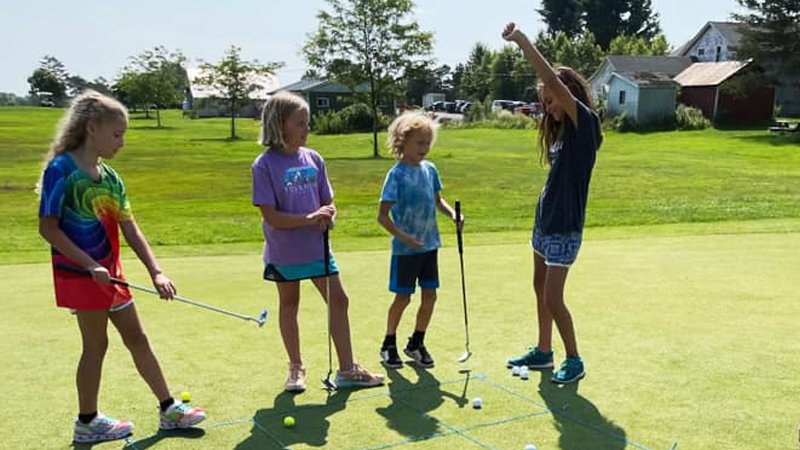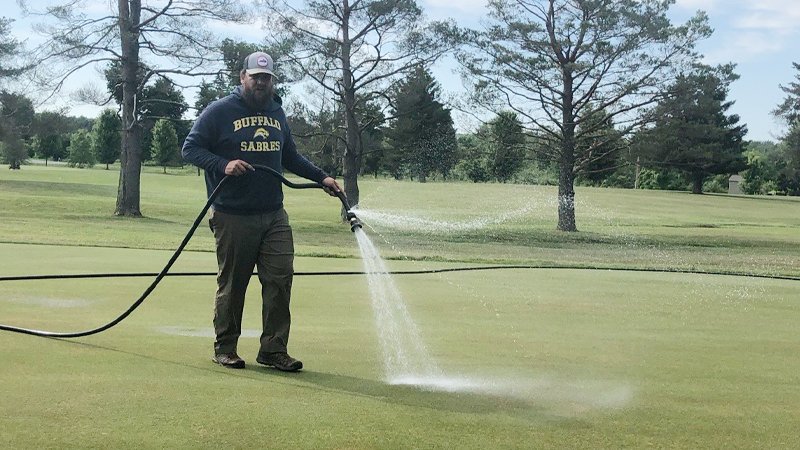As an owner, operator and superintendent, Matthew Woodcock spends a lot of time on the golf course.
Since he and wife Jill bought Old Erie Golf Club in Durhamville, New York three years ago, Woodcock increasingly spends more time on the course, even if the time allocated to various tasks changes year to year based on shifts in the number of customers playing the course.
"We've had steady growth of 15 to 20 percent every year since 2021," said Woodcock. "We're seeing a lot of new golfers. We are seeing more women and more kids who are 16, 17, 18 years old. We're seeing more demographics than we did three years ago.
"I had to hire someone to help on the golf course because we've grown so much."
That extra help allows Woodcock to spend more time inside Old Erie's modest clubhouse so he can tend to other business matters at the course located about 30 miles east of Syracuse.
Mind you, Woodcock is not complaining, and he welcomes the added business. Buying a golf course in the middle of a pandemic admittedly was a risk that has paid off for the Woodcocks. Indeed, there have been real costs (and benefits) stemming from the pandemic, and Woodcock's story is an example of how Covid has changed the business of golf.
Just about every industry has been affected since the start of the pandemic in 2020. Many of the changes have been positive, others not so much. Golf has not been immune.
The extra traffic is real. If there is 20 percent more play, then sure, there are going to be 20 percent more ball marks and 20 percent more divots. The more wear and tear there is, the more turf quality goes down, but that doesn't slow down golfers.
Millions of newcomers have taken up the game in that time, and fortunately many of them have stuck with it, leading to an unprecedented amount of play. The game's popularity has been on a constant uptick in participation for the past four years after two decades of decline.
The 520 million rounds played in 2023 were a record high. The Covid-driven surge in play during the past four years prompted Stuart Lindsay of Edgehill Golf Advisors to say in 2022: "It took us 19 years to lose 85 million rounds, and we regained all of them in two years."
Although play is way up, new course construction still is way down during most of the past two decades. There has been a net loss of about 1,500 courses during the past 18 years, according to industry reports. As course closings continue to outpace new construction, the average number of players per facility has exceeded what Jim Koppenhaver of Pellucid Corp. has said is supply-demand equilibrium of about 35,000 rounds per year per 18-hole equivalent by as much as 11 percent.
All that extra traffic can take a toll on turf conditions.
"What is the true cost of Covid? What is the cost of Covid with all that extra play?" asked Chris Hartwiger, director of agronomy for the USGA Green Section.
"The extra traffic is real. If there is 20 percent more play, then sure, there are going to be 20 percent more ball marks and 20 percent more divots. The more wear and tear there is, the more turf quality goes down, but that doesn't slow down golfers."
At Old Erie, Woodcock is devoting more time to maintaining the golf course due to the boost in play. He is aerifying the greens three times more than he did in 2021 when he bought the golf course.

"I am doing more cultural practices than ever. But I don't know if that is because of increased play, or because of my obsession with making this the best golf course it can be for $25 and a cart for nine holes," he said. "I'm also putting three times as much sand down.
"The last couple of years we've had warm, dry summers. We're blessed and cursed. We only irrigate our greens. That's 1 out of 77 acres. The rest is Mother Nature-dependent. We don't have any cart paths. That means golfers don't enter and exit the fairways at the same place, so that spreads out wear."
With play up and new course construction is down, many clubs are capitalizing on increased revenue streams to make improvements through restoration projects.
So many courses are or have been under renovation in the past several years that something as basic as sand has been difficult to come by, and contractors to move dirt often must be booked months in advance.
"Many are taking the money from all that extra play, and the smart ones are reinvesting it back into the club," said Thomas Bastis, CGCS, competition agronomist with the PGA Tour.
Labor continues to be a concern for many businesses since the pandemic when hourly workers across the spectrum were told they were non-essential. Since then, workers who have taken that message to heart have been slow to return to jobs flipping burgers, or raking bunkers. Many of those who have returned have made themselves available to the highest bidder, with golf often losing employees to other businesses in other industries.
Other challenges brought on since the pandemic include skyrocketing costs of new — and used — equipment, fertilizers, fungicides and pesticides, and supply chain issues that make getting that new machinery in a timely manner a true test of patience.

"Pricing has created real hardships. I've never seen anything go up in price like turf equipment has," Bastis said. "But the real problem is getting equipment delivered."
Those rising costs coupled with slow delivery times have trickled down, leading to an increased demand for quality used equipment.
Woodcock recalled shopping for a part that he found on the used market for $279, compared with $299 for the OEM alternative.
"At that point," he asked, "what's the difference?"
Woodcock has turned to a couple of different sources to help with used equipment, parts and even products to apply to the golf course.
When he needs something, as the owner and operator of a humble nine-holer, he relies on colleagues near and far. He scours social media for superintendents who might have what he needs, and he and his peers at a handful of other golf courses in the area share inventory with each other as needed.
"There are six or seven courses in the area, and we share parts with each other," he said.
We've had steady growth of 15 to 20 percent every year since 2021. We're seeing a lot of new golfers. We are seeing more women and more kids who are 16, 17, 18 years old. We're seeing more demographics than we did three years ago.
The same goes for fertilizers and chemical products applied to the golf course.
"If I need something and someone has some lying around, I'll ask if I can bum some off them until my order arrives," he said.
As the pandemic has helped lead more players to the golf course, it likewise has, in many cases, provided an avenue off the course for hourly labor, a barrier to success that is not unique to golf. The challenges associated with labor struggles, as well as the rising costs of equipment, fertilizers and pesticides also have provided an opportunity for superintendents in an area where they excel — innovating to find new ways to get the job done.
For many, that has meant leaning on technological advancements — like robotic mowers — in the face of a declining labor force. Dan Meersman at the Philadelphia Cricket Club has been an early adopter of using robotic mowers in out-of-play areas. He hasn't made the move to robotics because of labor problems, but that technology definitely has come out at just the right time for superintendents who want to shift more manpower to in-play areas as golfer demands increase.
"We have to be perfect every day," Meersman said. "(Robots) allow us to spend more time in areas that golfers care about."
Bastis agreed that robots are not necessarily a cure for a depleted labor force, but do allow superintendents to concentrate efforts on areas of increased need.
"Superintendents are asking themselves 'how can I make this better and do it cheaper?' I think that's why we're seeing so many (robots)," Bastis said. "Drones and robotic mowers, these types of things are not exorbitantly expensive. It's almost like why don't you have these things?
"There have been some challenges with Covid, but overall there is a lot of positive that has happened since Covid. I don't think anyone has anything to complain about."

